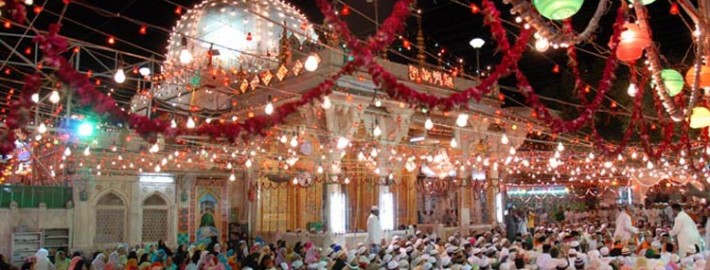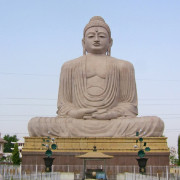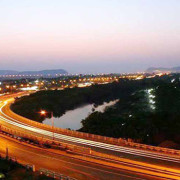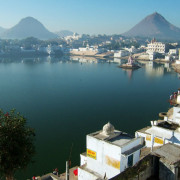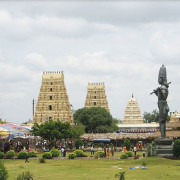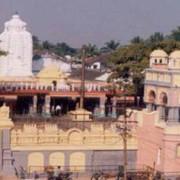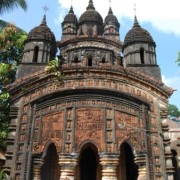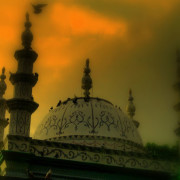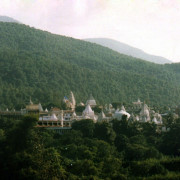Ajmer, Rajasthan – Enjoy the ultimate ecstasy amidst spiritual environment
Located in the southwest of of Jaipur, Ajmer is a haven wrapped in the green hills. In the 7th century Raja Ajay Pal Chauhan founded the city of Ajmer. Till 1193 A.D the Chauhans dominated the region. Then Prithviraj Chauhan lost it to Mohammed Ghori, after which Ajmer became home to many dynasties. Today, Ajmer is a popular pilgrimage centre for the Muslims as well as Hindus. Especially famous is the Dargah Sharif-tomb of the Sufi saint Khwaja Moinuddin Chisti, which is equally revered both by the Hindus and the Muslims.
Places to see in Ajmer: Ajmer is a religious place dotted with a number of religious places.
Taragarh Fort
The giant fort stands guarding the city. It has six gates. The fort also has Miran Saheb ki Dargah, who was the governor of the fort and laid down his life in an encounter. It gives a panoramic view of the city – situated in Nagpahari of Aravalli ranges. This fort has immense archaeological and historical importance.
Adhai – Din Ka- Jhonpra
This is a masterpiece of Indo – Islamic architecture. As legend goes, it was constructed in two and a-half days (Adhai-Din). It is a relic of an old mosque consisting of a quadrangle with a front screen wall of seven pointed arches. The distinct pillars and arched screen with its ruined minarets make it a splendid architectural masterpiece.
Raniji Ki Baori
Raniji-Ki-Baori or the step well was built in 1699 by Rani Nathavati and is asplendid work of Rajput architecture. One of the largest of its kinds, this step well is 46 m deep and is decorated with intricately crafted stone brackets. Enter through a high arced gate supported by ornately carved pillars and experience beautiful murals on pillars and gates.
Eighty-four-pillared Cenotape
As the name suggests, this is a pavilion supported by 84 (chaurasi) pillars. The pavilion was built by Rao Anirudh Singh in memory of his foster brother Deva. Remarkably constructed, this magnificent memorial serves as a cenotaph as well as a temple. A shiva linga (symbolic phallus) in the temple is still worshipped with great fervor.
Jait Sagar Lake
Surrounded by hills lies a beautiful lake built by Jaita Meena. The fleeting fountain in the lake looks amazing at night. Smarti Kunj and TerraceGardens are the other attractions of this lake.
Nawal Sagar Lake
This is a square shaped artificial lake, broken by islets and has atemple of Varuna (Aryan God of Wind) submerged in a corner. It is the main attraction of Bundi as a reflection of the entire city and its palaces can be seen in the lake, making it a fascinating sight at sunset.
Ana Sagar
It is an artificial lake named after Anaji Chauhan. The catchments were built with the help of local populace. The ‘Baradari’ pavilions were built by Shah Jahan to facilitate his long stay in Ajmer. The Baradari and the adjoining parks are the lungs of city and favourite outing spots.
Pushkar Lake
The pious Pushkar Lake is believed to have been created by the falling of a lotus from the hand of Lord Brahma. It is said to be as old as the creation itself. As per the Hindu Mythology there are Panch Sarovar (FiveLakes) namely, Man sarovar, Bindu Sarovar, Narayan Sarovar, Pampa Sarovar and Pushkar Sarovar. The lake is considered as one of the most sacred spots. The devotees believe that one dip in the waters of the lake on Kartika Poornima is equivalent to performing yagnas for several hundred years. The charming lake amidst the hills has fifty-two bathing ghats, built around the lake. The water around each ghat is supposed to have special healing power.
Savitri Temple
The temple is located on the hill behind the Brahma temple and one has to climb a long series of steps to reach the shrine. It commands a panoramic view of the beautiful lake and the picturesque surrounding villages.
Brahma Temple
This is the only existing temple dedicated to lord Brahma and was constructed in the 14th century, standing on a high plinth with marble steps leading up to it. A beautiful carved silver turtle sits on the floor facing the sanctum or Garbha Griha. The marble floor around the silver turtle is embedded with hundreds of silver coins, with donors’ name engraved on them.
Nearby attractions from Ajmer: From Ajmer you can make excursion to places like:
Kishangarh
Kishangarh is 27 Kms north east of Ajmer and was founded by Kishan Singh, a Rathore Prince. In the 18th century, it attained fame as one of the finest schools of miniature paintings. Though a smaller school with a much shorter duration it had a more refined style. It peaked under the patronage of Savant Singh, an heir to the throne who later became a hermit. It is said that Savant Singh modelled as Krishna while his mistress nicknamed as Bani Thani modelled for Radha. Paintings of Bani Thani are most celebrated. The artists of this school favoured evening lights and grey skies with fine colours. This outstanding school lasted only a few decades. Today the artists still create reproductions of the work. Kishangarh is now an industrial town for marble and textiles. It is connected by train and bus.
Tilonia
Tilonia is a small town 25 kms from Kishangarh near Ajmer and 7 kms off Jaipur-Ajmer highway. A distinctive feature of the town is Barefoot college, which began in 1972 with the conviction that solutions to rural problems lie within the community. The College, officially known as Social Work and Research Centre, addresses problems of drinking water, girl education, health and sanitation, rural unemployment, income generation, electricity and power, social awareness and the conservation of ecological systems in rural communities.
Things to do at Ajmer: Ajmer is an esteemed pilgrimage town. Feel the charm of the place that generates a feeling of ecstasy. At Ajmer you can be a part of the famous URS fair.
The lakeside city of Ajmer is located in central Rajasthan, and is held in great reverence by devotees of all communities who call it ‘Ajmer Sharif’ (Holy Ajmer). It is here that the mortal remains of the highly respected Sufi saint Khwaja Moin-ud-din Chishti lie buried. The pilgrims who come to seek the blessings of the Khwaja make rich offerings called ‘nazrana’ at the holy spot where the saint has been entombed. The offerings of rose and jasmine flowers, sandalwood paste, perfumes and incense contribute to the fragrance that floats in the air inside the shrine. Also offered by devotees are the ‘chadar’, ‘ghilaph’ and ‘neema’, which are votive offerings for the tomb. These are brought by devotees on their heads and handed over to the ‘khadims’ inside the sanctum sanctorum.
Best time to visit Ajmer: The best time to visit Ajmer is from the months of October to March.
How to go ?
By Air
The nearest airport to Ajmer is the SanganerAirport located at Jaipur, which is about 132 km from Ajmer.
By Train
Ajmer junction railway station lies on the Delhi-Mumbai railway line and is well connected to several cities in India like Delhi (Chetak Exp), Kolkata (Aii Sdah Exp), Mumbai (Aravalli Exp), Allahabad (Aii Sdah Expres) and Lucknow (Bsb Exp).
By Bus
Ajmer has a good network of roads connecting all the main cities of Rajasthan, including Delhi (394 km, Rs 200), Jaipur (134 km, Rs 150), Udaipur (300 km, Rs 200), Jodhpur (200 km, Rs 220), Jaisalmer (490 km, Rs 300) and Bharatpur (312 km, Rs 220). Ajmer is connected to Delhi also by road.
Where to stay ?
There are abundant lodging facilities in Ajmer. Some options are:
Hotel Khadim (RTDC): +91-0145 262 7490
Hotel Sahil: +91 – 0145 – 2632511 Website: www.hotelsahilajmer.com
Hotel Shankar Palace: +91-0145-5100850, 875 Website: www.hotelshankarpalace.com
Note : Phone numbers given above are according to the information available with us. If you find any contact number/s given above is/are incorrect or not in use, please let us know.
,
,

